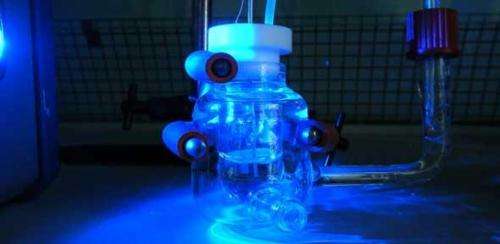Air, water and sun: The ingredients of 'green gasoline'

(Phys.org) —Mimicking a natural process perfected over billions of years to capture solar energy, researchers are creating artificial photosynthetic systems that will turn air and water into transport fuel.
In a matter of decades, homeowners might have their own power plants that use sunshine not only to power their homes but also to synthesise petrol for their cars. This is the vision of chemist Dr Erwin Reisner, who is working towards developing the process that could make this future energy scenario possible, and could also be scaled up to provide industrial levels of fuel production.
"The sun provides our planet with a continuous flow of electromagnetic and carbon-free energy and really is the most obvious and abundant energy source that is capable of sustaining humankind's long-term energy demand," he said.
"Given that almost 80% of the world's energy is used in the form of fuels, one of the main challenges is to create a carbon-neutral, sustainable alternative that is cost-effective enough to replace the usage of petrol and diesel."
The energy stored in fossil fuels came originally from the sun. So too does the energy generated by the systems being developed by Reisner and colleagues. But the energy is created in real-time, unlike the millennia needed to create oil, coal and gas from the remains of plants and animals.
The technology uses solar energy to separate the elements that make up water and carbon dioxide (CO2). The reaction creates synthetic gas, or syngas – comprising energy-rich hydrogen (H2, which can itself be used as a fuel) and carbon monoxide (CO) – and this mixture of gases can be converted into liquid hydrocarbons such as petroleum through an established industrial process.
"Syngas has been made successfully at an industrial level for decades by the petrochemical industry for the production of pharmaceuticals, plastics and fertilisers," explained Reisner, who leads the Christian Doppler Laboratory in the Department of Chemistry, "but it requires fossil fuels to make syngas, thereby depleting our natural reserves and producing the greenhouse gas CO2 as a by-product. It's therefore neither renewable nor clean.
"The process we are developing is sustainable because it uses sunlight-driven water splitting and takes carbon from the atmosphere only to return it when the syngas is used for the release of energy."
The chemists took their lead from the natural world. For example, hydrogenases, found in many microbial organisms, are biological catalysts capable of producing H2 from water. Reisner's team has created a synthetic small molecule that mimics the activity of hydrogenases and is stable to use. Moreover, whereas efficient H2 generation requires the catalyst platinum, which is expensive and in relatively short supply, the artificial catalyst uses the abundant metals iron, nickel and cobalt.
A first milestone was reached last year when the scientists successfully demonstrated that it is possible to generate H2 in a test-tube on the bench, in air, by mixing the synthetic catalyst with a dye that absorbs light and water. "An H2 evolution catalyst which is active under elevated oxygen levels is crucial if we are to develop an industrial water-splitting process," explained Reisner. "A real-world device will be exposed to atmospheric O2 and also produce O2 in situ as a result of water splitting. It was always thought this was very hard to do, but we showed that it is possible."
Now a further milestone has been reached. "In nature, hydrogenases take up electrons from their environment – and in fact this provides a valuable 'mopping up' process to remove them," he added. "We wanted to find a way of providing these electrons to our synthetic catalyst in a sunlight-driven reaction and we turned again to biological systems for clues. Without the electrons, the hydrogenase or synthetic alternative can't work."
Photosystem II (PSII) is a plant protein that captures photons of light and uses them to energise electrons and oxidise water to produce O2. The researchers have now integrated this protein in a synthetic system to extract electrons to produce H2. "What we are creating is an artificial metabolic pathway – one that wouldn't conventionally occur in nature. By combining our synthetic version of PSII and a synthetic hydrogenase, the former captures light energy and feeds electrons to the latter."
Artificial photosynthesis is an intense research area worldwide. Where Reisner feels his team can make the most difference is his cross-disciplinary approach and innovative combination of light harvesting, water oxidation and hydrogen generation: "It's a challenge to combine all three but we are now able to couple light capture directly through to fuel generation and we are moving towards achieving this with high efficiency."
Because the synthetic catalysts are much smaller than their biological counterparts, they can be concentrated on a solid structure, enabling the chemical reaction to continue more efficiently than would be possible naturally.
But can the technology make the transition from test-tube to the gigatonnes required for industrial scale-up? "We have to be realistic and a series of true breakthroughs is still required to make our scenario a reality. Even if we have these tomorrow, it will take at least 20 years before we see this type of technology providing the majority of the world's transport fuel," cautioned Reisner. "That said, we are confident that renewable syngas, a 'green gasoline' technology, will be able to drive our current industry in a sustainable way. Our approach is attractive, because it allows our current transport infrastructure to be maintained with only a small adaptation."
Provided by University of Cambridge


















